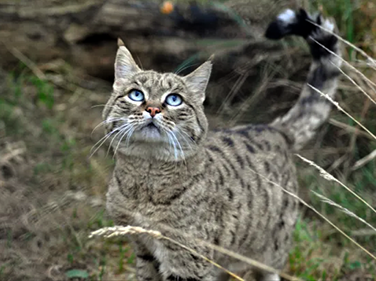Important Facts For Prelims
Indian Desert Cat
- 20 Dec 2021
- 3 min read
Why in News
Recently, an Indian Desert Cat has been spotted for the first time in Madhya Pradesh’s Panna Tiger Reserve (PTR).
- The Indian Desert Cat is also known as the Asiatic Wildcat or the Asian Steppe Wildcat.
Key Points
- Scientific Name: Felis silvestris ornata

- About:
- It is usually a creature of the Thar desert in Rajasthan, and inhabits scrub desert areas.
- The cat occurs in arid and semi-arid zones of western India which includes Gujarat, Rajasthan, Madhya Pradesh and Maharashtra up to Pune and Nagpur.
- This cat is found in deserts and can survive without water.
- The toes of the species have cushion-like hair which help it balance the fluctuating desert temperatures.
- Habitat:
- It can be found mostly in scrub deserts, up to 2,000-3,000 m elevation, mountainous areas with sufficient vegetation, as well as temperate forests.
- The Asiatic wildcat usually occurs close to water sources but can also live in low-water areas. It does not seem to avoid cultivated areas and human settlements.
- It avoids vast deserts, dense forests and deep snow.
- Threats:
- It possesses beautiful soft fur, hence, most sought after in the international fur trade.
- Hybridisation with domestic cats can lead to the loss of genetic information and is thought to be one of the main threats. Hybridisation was reported from Pakistan and Central Asia and is most likely also a problem in India.
- Another important threat is from poaching related to conflict with humans.
- Habitat destruction and reduced habitat quality remain important issues. The Asiatic wildcat is under heavy pressure due to land use changes.
- Rodenticides and other chemicals may also threaten it.
- Protection Status:
- IUCN Red List: Least Concern
- CITES: Appendix-II
- Wildlife protection Act’s: Schedule-I.
Panna Tiger Reserve
- Location:
- It was established in 1981 and is situated in the Vindhya mountain range in the northern part of Madhya Pradesh.
- Ken river (a tributary of the Yamuna River) flows through the reserve.
- The region is also famous for Panna diamond mining.
- Ken-Betwa river interlinking project will be located within the tiger reserve.
- Recognition:
- In July, 2021, PTR was awarded the Conservation Assured Tiger Standards (CAITS) certificate by the National Tiger Conservation Authority for meeting the established international standards for tiger conservation and management.
- The United Nations Educational, Scientific and Cultural Organization (UNESCO) designated the Panna Tiger Reserve as a Biosphere Reserve on August 25, 2011.
- Other Tiger Reserves in Madhya Pradesh:
- Sanjay-Dubri.
- Satpura.
- Bandhavgarh.
- Madhav National Park
- Pench Tiger Reserves






